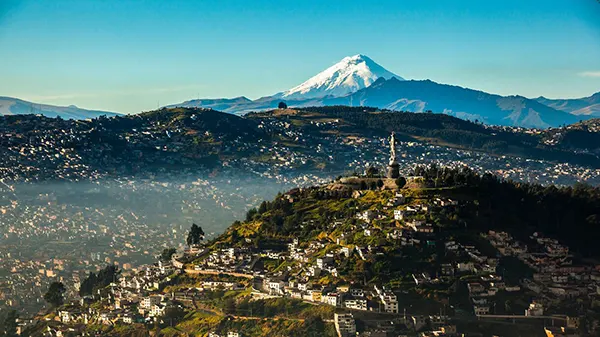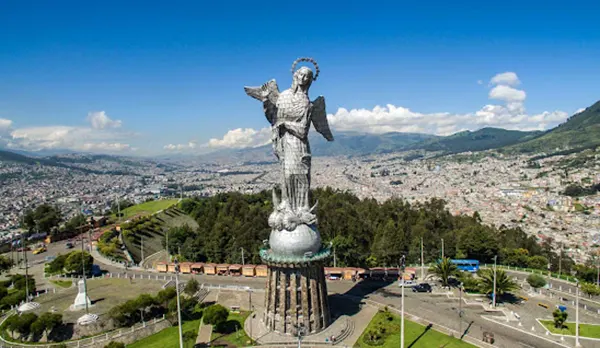
Quito (Ecuador): How the Capital above the Equator Blends History, Volcanoes and Modernity
Located high in the Andes at an altitude of over 2,800 metres, Quito is one of the world’s most remarkable capitals. It combines colonial charm, breathtaking mountain views, and a vibrant modern lifestyle. Recognised as a UNESCO World Heritage Site, the city captures both the deep traditions of Ecuador and its evolving urban pulse of the 21st century.
The Historic Heart of Quito
The old town of Quito is a living museum that preserves centuries of Ecuadorian heritage. Its cobblestone streets, adorned with Spanish colonial architecture, lead to majestic squares and churches, each reflecting the city’s spiritual and cultural evolution. The iconic La Compañía de Jesús, with its lavish gold interior, stands as one of South America’s finest examples of Baroque art.
Another central attraction is Plaza Grande, where the Presidential Palace and the Metropolitan Cathedral mark the political and religious core of the capital. Locals gather here daily, blending politics, prayer, and everyday conversation in a uniquely Ecuadorian way. The preservation of these sites underlines the nation’s commitment to maintaining its identity amidst globalisation.
Quito’s historic district also offers a deep sense of continuity. Street vendors sell traditional sweets alongside modern cafés and boutiques, showing how the city’s past and present coexist harmoniously. Tourists and residents alike find inspiration in this fusion of eras.
Museums and Cultural Heritage
Beyond its streets, Quito’s museums reveal layers of history and identity. The Museo Nacional del Ecuador displays artefacts dating back thousands of years, from pre-Columbian pottery to republican-era relics. The Casa del Alabado Museum goes even further, focusing on indigenous spirituality and symbolism before Spanish colonisation.
Modern art is equally celebrated at the Centro de Arte Contemporáneo, housed in a former military hospital. It symbolises the transformation of old structures into spaces of creativity. Through exhibitions, installations, and workshops, local and international artists continue to shape Quito’s contemporary cultural dialogue.
The cultural landscape is completed by regular festivals such as Fiestas de Quito, where parades, music, and traditional dances fill the streets each December. These events strengthen the bond between residents and their ancestral heritage while embracing the rhythm of modern life.
The Volcanic Landscape and Natural Wonders
Quito’s dramatic geography makes it unlike any other capital in the world. The city lies in a long Andean valley, surrounded by volcanoes such as Pichincha, Cotopaxi, and Cayambe. The skyline is both awe-inspiring and humbling, reminding everyone of nature’s immense power and beauty.
The Pichincha Volcano, visible from most parts of the city, is particularly significant. Locals often ascend via the Teleférico cable car, which reaches over 4,000 metres above sea level, offering a panoramic view that stretches far beyond the urban area. Despite its proximity, the volcano is carefully monitored for activity, ensuring safety while attracting adventurous hikers.
Just outside the city lies Mitad del Mundo, the “Middle of the World” monument marking the equatorial line. Visitors can stand with one foot in each hemisphere—a unique experience that embodies Quito’s geographical and symbolic significance. This site represents Ecuador’s name itself, which derives from the word “equator.”
Climate and Ecology
Thanks to its altitude, Quito enjoys a mild, spring-like climate throughout the year. Temperatures rarely exceed 25°C or drop below 10°C, making it pleasant for residents and visitors alike. Rainfall is common but brief, refreshing the city and maintaining its lush green hills.
The surrounding areas, such as the Pululahua Geobotanical Reserve, offer diverse ecosystems filled with endemic flora and fauna. The reserve, located inside a dormant volcanic crater, is one of the few inhabited calderas in the world. It provides a serene escape for ecotourism enthusiasts seeking balance between nature and local culture.
In recent years, Quito has made significant efforts toward environmental sustainability. Projects focused on reforestation, clean energy, and public transport reflect the city’s growing ecological awareness. These initiatives aim to preserve its fragile highland ecosystem while improving urban living conditions.

A Modern City with a Dynamic Future
Quito’s transformation in the last decade demonstrates Ecuador’s progress and innovation. The expansion of the Metro de Quito, inaugurated in 2023, has revolutionised public transport, reducing traffic and connecting distant neighbourhoods. This development marks a milestone in the city’s pursuit of modern efficiency.
Business districts like La Carolina and González Suárez showcase modern architecture and a cosmopolitan lifestyle. International restaurants, shopping centres, and cultural spaces are integrated into everyday life without overshadowing the city’s historical essence. This urban evolution reflects the growing confidence of Ecuador’s capital as a regional hub.
Education and technology also play a vital role in shaping Quito’s future. Universities and research institutes collaborate on projects that promote sustainability, tourism, and social innovation. Through such initiatives, the city continues to evolve while maintaining respect for its cultural and natural roots.
Tourism and Local Life
Quito’s tourism industry has adapted to modern trends without losing its authenticity. Boutique hotels and eco-lodges provide sustainable accommodation options that respect the local environment. Guided tours often focus on heritage, gastronomy, and outdoor exploration, highlighting the city’s versatility.
Local markets like Mercado Central offer a vibrant look at everyday Ecuadorian life. Visitors can taste exotic fruits, enjoy street food, and observe the social rhythm of the capital. These interactions bring travellers closer to the heart of the Andean culture.
Today, Quito represents more than just Ecuador’s administrative centre—it symbolises a living bridge between nature, culture, and modern innovation. Its harmony of heritage and progress makes it one of South America’s most fascinating destinations in 2025.
